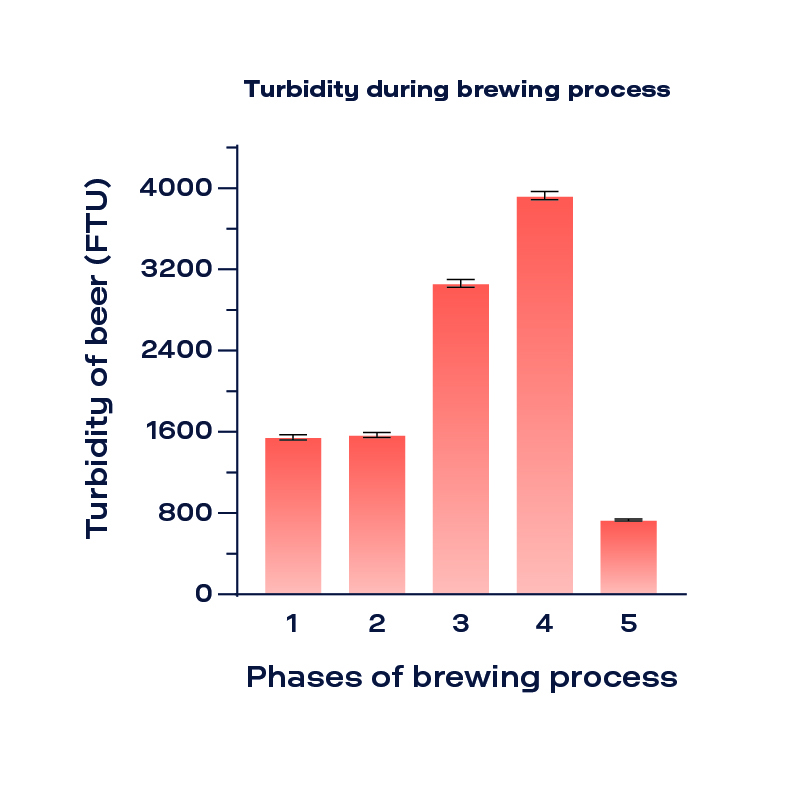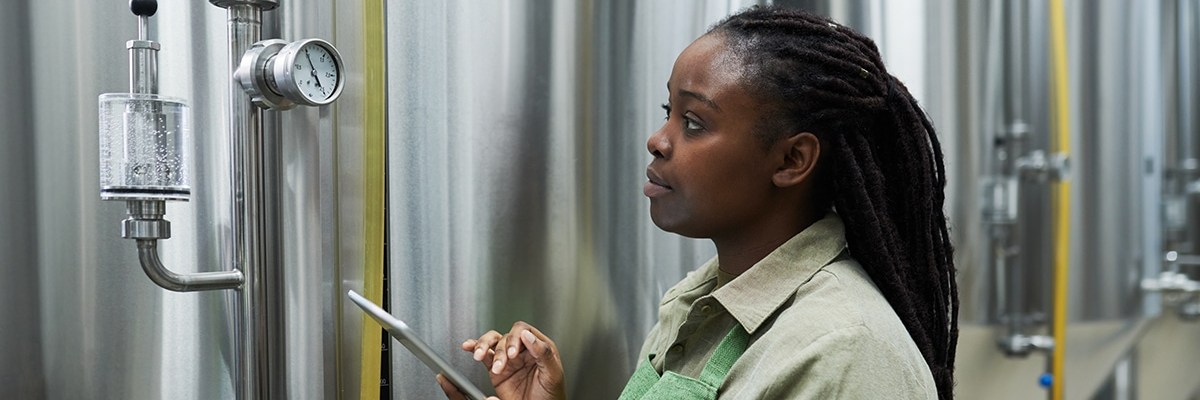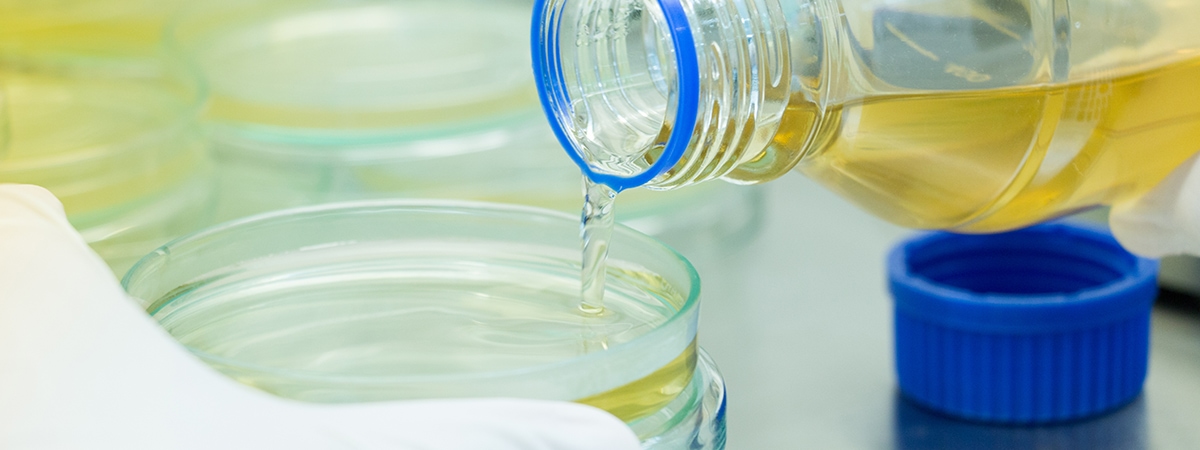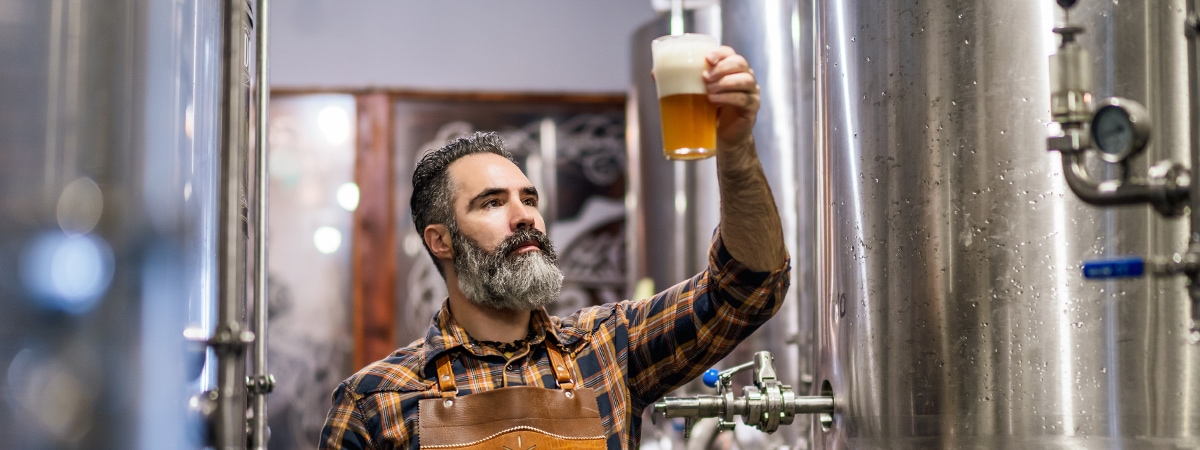Application Note | TURBIDI.T™
In collaboration with
HOW DOES THE TURBIDITY OF BEER CHANGE DURING THE BREWING?
NOTICE
This study was performed in collaboration with the microbrewery EtOH (Montréal, QC) which brewed and provided the different tested beers.
Summary
- Monitoring beer turbidity (or haze) is crucial in brewing to ensure quality and flavor.
- The TURBIDI.T™ was used to measure the turbidity of samples collected at various stages during the brewing process of an India Pale Ale (IPA).
- The turbidity increased along the first four steps of the brewing process and decreased in later stages, close to consumption.
Introduction
Beer brewing is a complex process that involves multiple phases and parameters to ensure consistent quality and flavor. From malting and milling the grains to fermenting and conditioning the beer, each step of the brewing process must be carefully monitored and controlled to achieve the desired result. One important parameter to be controlled throughout the process is the turbidity or haze of the beer [1].
Turbidity is a measure of the amount of suspended particles or solids in a liquid, and can indicate the quality at various stages during the beer production [2]. For example, after fermentation and before packing, it is crucial to monitor the turbidity of the beer to ensure that the yeast has properly settled out of the liquid and to prevent any remaining solids from affecting the flavor or appearance of the beer.
In order to monitor turbidity throughout the brewing process, breweries often use turbidimeters, which measure the amount of light that is scattered by the particles present in the liquid. In this work, the turbidity of samples collected from different stages of an India Pale Ale (IPA) brewing process was measured using the TURBIDI.T™.
Materials and Methods
Samples from five consecutive stages of an India Pale Ale (IPA) brewing process (EtOH microbrewery, Montréal, QC) have been collected. The stages can be described as follows:
(1) Wort phase: liquid extracted from the mashing process (mixture of infused grains and water)
(2) Proliferation phase: proliferation of the yeast after 24h of yeast addition (a.k.a. lag phase)
(3) One week fermentation and first addition of dry hop
(4) Two weeks fermentation and second addition of dry hop
(5) Post-conditioning phase (or crash phase): in cold environment to facilitate the sedimentation of suspended particles such as yeast and proteins.
Samples were frozen at -20°C until tests were performed. Previous to testing, the TURBIDI.T™ equipment was calibrated with formazin standards (FTU). Samples were thawed and incubated at 25°C and 3 vials were prepared for each step of the brewing process (n=3) to be tested in the TURBIDI.T™. Average results are expressed as mean ± standard deviation.
Results and Discussion
Turbidity evolves through the beer brewing process. During the wort phase, the liquid extracted from the malted barley initially mixed with hot water (to extract the sugars needed for fermentation) has relatively low turbidity levels (stage 1: 1546 ± 25.90 FTU). The yeast is then added to begin the fermentation process. During the first 24h, the yeast starts proliferating (lag phase) and no significant increase was found in turbidity (stage 2: 1570 ± 23.10 FTU).
During the fermentation phase, the yeast begins to consume the sugars and produce carbon dioxide and fermentation byproducts, including proteins, amino acids, and polysaccharides. After one and two weeks of fermentation, the beer became more cloudy as the yeast continued to consume the sugars and produce more suspended particles. Additionally, dry hop additions further contributed to this increase in turbidity. Indeed the turbidity increased to 3062 ± 38.56 FTU and 3927 ± 40.37 FTU at stages 3 and 4, respectively.
Finally, after fermentation is complete, the beer is transferred to a cold-conditioning tank, where it is cooled to near-freezing temperatures for 4 days. During this stage (stage 5), the beer undergoes a natural clarifying process due to the sedimentation of the suspended particles resulting in the decrease of its turbidity, which was the lowest value among the analyzed stages (734.8 ± 8.89 FTU).


Figure 1: Turbidity levels in five different phases of beer brewing process: (1) Wort phase (pre-fermentation of beer); (2) Lag phase (after 24h of yeast addition); (3) 1 week fermentation and addition of hop; (4) 2 weeks fermentation and addition of hop; (5) Post-conditioning (in cold environment to facilitate particle sedimentation).
Conclusions
Therefore, this study showed that:
- Measuring the turbidity of beers is made easy with the user-friendly TURBIDI.T™ instrument.
- Turbidity measurements can be gathered and stored on a tablet and can be exported as needed.
- The TURBIDI.T™ can measure the turbidity changes in real time within the sample providing insights to the sedimentation kinetics when applicable.
The TURBIDI.T™ instrument allows for a scalable testing platform, where multiple units can be connected to the same tablet for increased efficiency.
Contact Us to Get a Quote or to Learn More
References
Related Posts
Growing demands for quicker cell quantification methods push beyond traditional cell counting chambers, prompting innovative solutions that facilitate accurate counting while diminishing time. Turbidity, reflecting solution cloudiness in the presence of light scatterers, emerges as an effective means to accelerate cell quantification. In this application note, a strong correlation was established between turbidity (FTU) of a S. cerevisiae culture solution and cell numbers (cells/mL) counted with a conventional cell counting chamber. Utilizing TURBIDI.T™ for accurate turbidity measurements offers a user-friendly...
In the realm of bioengineering and biotechnology, cells serve as catalysts for the production of diverse valuable products, such as biofuels, pharmaceuticals, antibodies, industrial enzymes, and bio-based chemicals [1]. Within this context, yeast, a widely utilized microorganism, plays a pivotal role. Monitoring yeast growth is of utmost importance to ensure optimal conditions and productivity in biotechnological processes [2]. Traditionally, spectrophotometric analysis has been used to assess the optical density at 600 nm (OD600nm) by measuring the absorption of light by the yeast ...
The sedimentation kinetics of suspended particles provides crucial information for optimizing manufacturing and infrastructure across industries, while also contributing to the design of drugs and cell therapies. Turbidimetry is a quick and nondestructive method to precisely determine the sedimentation kinetics of suspended particles. The decrease in turbidity of silica particles in distilled water as a function of time was obtained with high precision using the TURBIDI.TTM. This curve gives information about the sedimentation behavior and rate of the suspended particles ...
The determination of particle size is important in many fields, such as life sciences (nanomedicine, drug delivery, tissue engineering, bioanalysis), chemical, environmental sciences and industries. Turbidimetry is a quick and nondestructive method to estimate particle size following an easy-to-follow procedure. Curves of turbidity vs silica particle concentration in distilled water of various sizes were obtained with high precision using the TURBIDI.TTM. These curves can be used to build a reference curve for the determination of particle size.
A suspension is a mixture in which solid particles (organic or inorganic in nature) are dispersed in a liquid medium, but not dissolved. Suspensions are usually opaque or cloudy and can settle over time due to gravity. They have a broad range of applications and are present in various industrial processes, such as chemical, pharmaceutical, food and beverage, and environmental industries. During the production of pharmaceutical formulations for example, professionals may measure particle concentration to assess whether particles have aggregated or formed larger clusters to optimize the process and ensure product quality.
Turbidity provides the consumer’s first visual impression of beer quality. Beer turbidity, technically known as haze, can be a desired or an undesired effect. Industrial beer companies normally choose to filter their beer and follow a precise quality control analysis with the aim of reducing the haze. Consumers expect a filtered beer to be a clear, bright and non-hazy product that remains so during its shelf life. On the other hand, artisanal beers normally have higher haze to maintain their unique flavor and appearance, specially for some types of beers such as New-England Indian Pale Ale (NEIPA).








